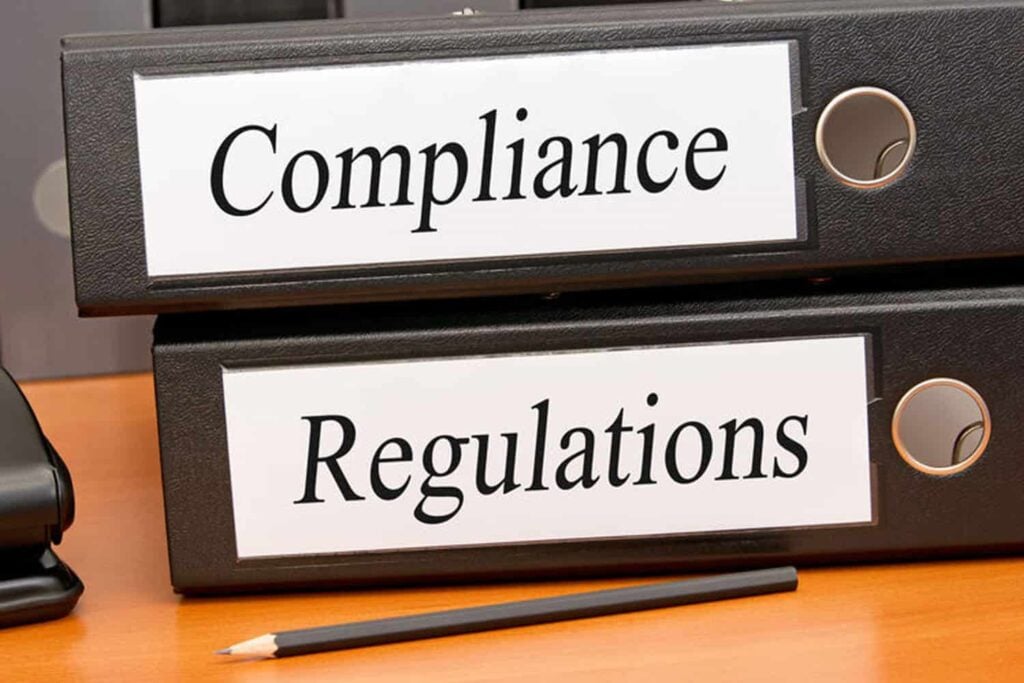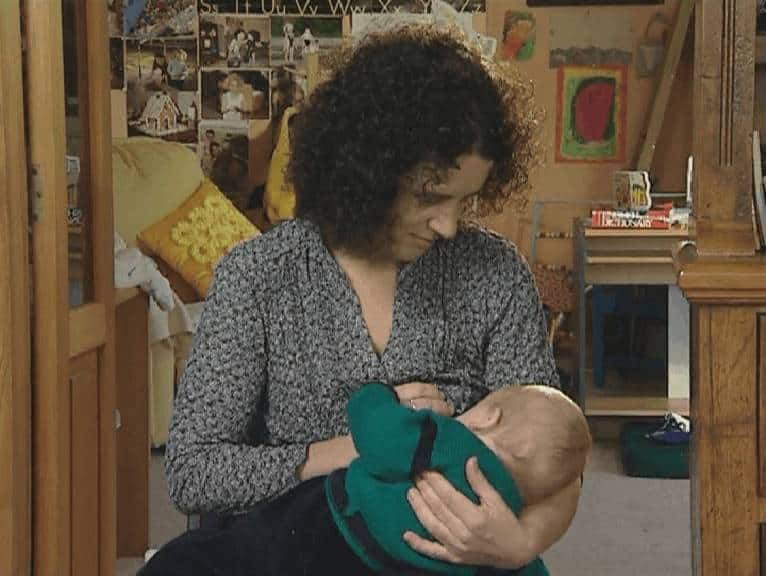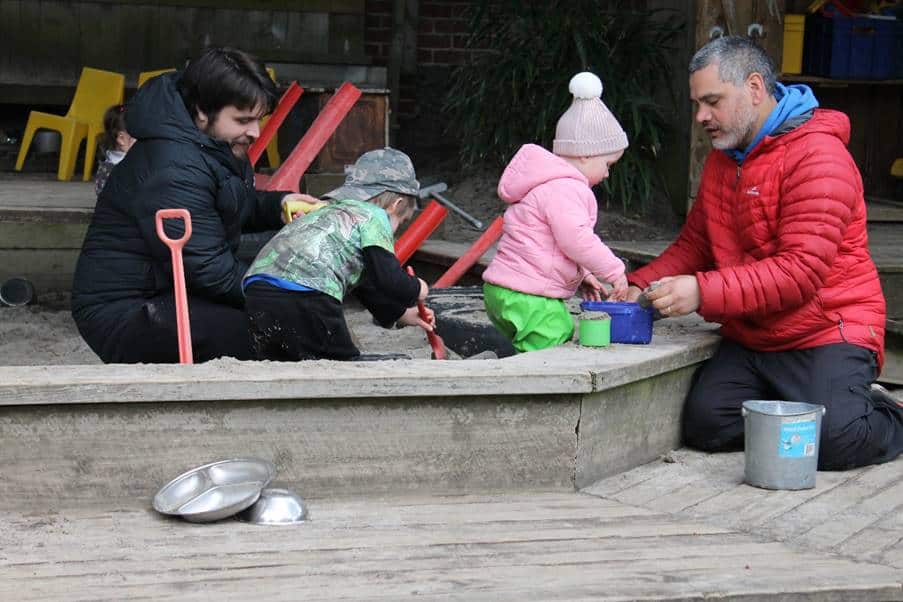This is a report of findings related to workplace safety from the 2014 ECE Quality and Employment Survey.
More than 700 people took part in the survey from a range of private and community-based ECE services including centre-based and home-based services across New Zealand.
The key findings were as follows:
- Workplace related injuries, mental health and physical problems were suffered by close to one-third of staff (29%) over a 12 month period.
- High to extreme levels of stress over a typical week were reported by close to one-quarter of staff (23%).
- Bullying was experienced by one quarter of all staff surveyed (25%) and by as many as 34% of qualified teachers working in general teaching positions at kindergartens and childcare centres. Most bullying took the form of staff being at the receiving end of personal nastiness and prejudices, being made to feel their job was at risk if they did not comply with what they viewed as unfair or unrealistic expectations, and not having control over matters that impeded the quality of their work with children.
- Workloads were described as being excessive by about one-quarter of staff (24%) while 44% indicated their workloads were just bearable.
General observations from the results about Workplace Safety
Although many staff reported suffering physical injuries or work-related mental health issues, their comments suggest they often attributed this to being something that was part and parcel of working in an ECE setting and therefore while the risks were known there was little focus on managing or reducing these risks.
Some staff felt that they could not let on that they had an injury or health issue in case of negative response, and this, combined with reports of bullying suggests that not all early childhood services have a culture of inclusion and respect, and also some may have little real staff involvement in health and safety matters and decisions.
There was no significant difference between reports of health and safety issues for workers at private/commercial and public/community-owned early childhood services.
A smaller proportion of staff at Home-based ECE agencies reported harm (19%) compared to kindergarten staff (28%) and childcare centre staff (30%).
Stress, fatigue and mental illness
Stress manifested in a number of different ways with the most common areas being:
- Work-life balance: for example having to change shifts at the last minute putting pressure on caring for own children or a lack of holiday time especially for new or training teachers
- Pressure of responsibility and workload: some teachers reported additional stress when they moved into supervisory positions, the pressure of dealing with paperwork and administration was also a source of stress, for example, the expectation of documenting children’s learning was impacting on time actually spent with children.
- Staff relationships: respondents indicated that stress was caused through bad relationships with bosses or other colleagues. Some staff in supervisory roles also experienced stress when trying to resolve staff issues.
- Physical injury: injuries were often described as leading to other problems including emotional stress.
- Dealing with children’s individual needs and high needs children: some respondents said it was stressful and emotional dealing with children with special needs or who had suffered trauma, also there were issues responding to children’s needs for care and attention due to understaffing.
- Job security at threat: including a threat of staff reductions due to falling rolls or restructuring
Staff responded to these stresses in various ways with many suffering emotional or physical manifestations of the stress including:
- Panic attacks
- Chronic anxiety
- Depression
- High blood pressure.
- Exhaustion/fatigue
- Severe migraines/stress induced headaches.
- Sleep deprivation.
- Weight gain
Regular stress levels
Staff were asked “In a typical week, how often do you feel stressed at work?” Nearly half (42%) said they experienced stress slightly or not at all often, 35% said they were stressed moderately often and 23% said they were extremely stressed or experienced stress very often.
Staff who reported feeling stressed only slightly or not at all during a typical week (42%) mentioned features of an emotionally healthy work environment for themselves, involving: good collegial relationships, a manageable workload, not too many children and good staffing ratios with colleagues who were qualified teachers.
Some worked part-time or had reduced their work hours to better manage – or not become affected by stress. And some believed their personality and attitude provided a buffer and helped them to cope perhaps better than some of the colleagues did.
Chief causes of daily stress were relationships with co-workers and bosses, carrying the workload for other staff, lack of breaks and time-off, challenging children, inadequate staffing for the number of children, not feeling able to meet expectations, constant tiredness, and trying to combine work with study.
Bullying
One-quarter of early childhood education staff (25%) in the survey had been or were subject to bullying at their present place of work. At kindergartens and childcare centres a much higher proportion of qualified teachers working in general teaching positions reported being bullied (34%), than managers, senior and head teachers and team leaders (18%) and untrained teachers (20%).
It also occurred at other types of early childhood services. For example, six out of 26 staff at home-based ECE agencies experienced bullying and four out of the 10 Playcentre staff in the survey.
The nature of the bullying experienced by staff in management and leadership positions mainly concerned defining relationships and setting boundaries with staff reporting directly to them and also the people they reported to, namely: board members (community-based services) and business managers or service owners. Examples of the types of bullying experienced by managers and other staff in leadership positions were:
- Older teachers who did not want things to change and rebelled against those trying to make change
- Board chairman bullying staff
- Board members not listening or insisting they were right when that was not the case
The nature of the bullying experienced by staff other than managers and leaders mainly concerned personal nastiness and prejudices, being made to feel their job were at risk if they did not comply with unfair and what they saw to be unrealistic expectations, and not having any control over matters that impeded the quality of their work with children.
Examples included:
- Being talked about because of a different background or culture
- Being deemed less knowledgeable due to not having children
- Being looked down on due to not being fully qualified and registered
- Being afraid that jobs would be lost if meetings outside of work hours were not attended
- Non-contact time being reduced or taken away
- Being made to tidy up or carry out other tasks after work hours unpaid
- Being strongly discouraged from filling in teacher accident reports
- Being threatened with teacher registration paperwork not being signed off
Workload
Close to one-quarter of early childhood education service staff (24%) rated their workload as being excessive. Another 44% rated their workload as being bearable and only 32% thought it was fine.
Comments showed that when workload was considered fine, the respondent worked in a team that shared the workload well and found a balance between time with children and paperwork as well as getting sufficient non-contact time.
Among the staff whose workload was excessive, the key problem was a lack of time to fit in job requirements and meet workplace expectations. Staff in management and leadership positions said they needed more support with admin and for paper-work requirements, such as for the Education Review Office, to be made more manageable (and especially if they were working at smaller stand-alone services).
Many reported not being able to take breaks as they had to cover responsibilities or do paperwork.
Among staff in teaching positions, there was a feeling that their workload needed to be reduced to control tasks that were taking them away from their teaching, and are unable to be completed during working hours. Staff reported often feeling pressured and not always having enough non-contact time to complete assessments of children’s learning and other planning in paid time.
Teachers in training and teachers gaining and maintaining their teacher registration also reported that on top of working a full day they were left struggling to meet the needs for study and writing.
Physical harm and illness
The majority of physical issues reported were injuries either caused by one-off incidents while at work, or attributed to the on-going strains and stresses on the body through working in ECE.
Only a small percentage of respondents reported suffering from a contagious illness such as chicken pox or school sores which had been caught through their work.
Of the physical injuries, back injuries were one of the most common problems cited, along with shoulder, arm, knee and foot issues.
Many of these were caused by the nature of the early childhood setting and working with young children, for example:
- back pain from picking up infants for nappy changes, putting them in a cot etc.
- back problems from lifting heavy equipment
- back pain from bending over low tables to interact with children, clean and prepare activities
- knee problems from kneeling down to children’s level
- shoulder and wrist problems from extended computer use
Falls and slips were also common causes of injuries including slipping on wet or muddy surfaces.
Some respondents commented that their injuries had been caused by unsafe equipment, or badly maintained areas such as storage sheds not being filled safely, toys being left out or furniture blocking the way.
Injures caused directly by children were less common than those that were accident related and were mentioned only by staff who were at kindergarten and childcare centre workplaces.
Injuries caused by children included:
- being bitten by children
- back, arm and shoulder injuries due to children playing roughly or needing to be held by the hand but pulling away frequently
- being hit by a child
In some cases, the problem of the physical injury was then compounded by a lack of support from the ECE service which led to other issues including financial difficulties and stress. For example one teacher said:
I injured my shoulder and I lost wages when I had to attend the doctors and x-ray dept. Also my centre manager made me rearrange my appointment which has meant I have had to wait two weeks before being seen by a health professional. (childcare centre)
Analysis and how this information could be used
The survey results show that staff within the ECE sector have suffered from stress, excessive workloads and even bullying in the workplace.
This last one is of extra concern not only because bullying should not occur in any workplace but that it occurs in settings where there are young children who may witness this, at an age when bullying can be learnt, and the children are cared for by affected teachers.
It is not easy to say whether the ECE sector has more or fewer injuries and stress-related problems than other industries and comparable occupations such as school teaching, without carrying out a detailed comparison of injury rates. But, with nearly a quarter of teachers saying they suffered excessive stress and a quarter reporting workplace bullying there is a suggestion that the sector as a whole and ECE services individually need to make sure they are doing their best for workers.
Important for ECE Service Providers and Teams to take Action
WorkSafe NZ states that: “a healthy and safe workplace starts with identifying and understanding what your work-related health and safety risks are; particularly those that have the potential to cause people serious harm or illness. It then involves doing what is sensible and reasonable to eliminate or, where they can’t be, manage those risks.”
Clause 2 of the ‘Code of Ethical Conduct for Early Childhood Services’ emphasises the obligation of service providers to ensure the well-being of all members, including staff. Early childhood education providers, supported by the Education Review Office, could engage in self-review on clause 2c “Early childhood service adults provide role models to children of respectful and inclusive behaviour”, and clause 2d “Any instances of hateful, hurtful or discriminatory behaviour (including bullying), attitudes, and language by any adult or child at the early childhood service are picked up promptly before escalation and addressed in a constructive and considerate way.”
Under the new Health and Safety at Work (2015) Act an early childhood service is classified as a PCBU (person conducting a business or undertaking – which can also be a company) and it, therefore, has a primary duty of care to ensure worker health and safety. A service must review what it does to ensure staff safety and how critical risks (such as small furniture and clutter, and workload) can be managed.
Under the Act employers are also now expected to be open to staff raising concerns and offering suggestions for improving health and safety.
Early childhood education providers can use the information presented in this report to begin a conversation with their staff on health and safety, and as a starting point for reviewing practices and risk management. An example might be identifying that back injury prevention is important and looking at how the risk of back injuries can be managed including what changes might be made in the physical environment and what responsibility staff may take for example, by learning about and using methods of safe bending and lifting.
Reviewing individual staff workloads would help to define what can be realistically managed within working hours to reduce the risk of burnout, illness and staff leaving or losing their intrinsic motivation, all of which could have a knock-on effect on children at the service. Also, regular monitoring of staff workloads would help ECE providers and managers to see where there may be needs for more staffing or re-arrangement of duties and hours according to staff areas of expertise and confidence.
Ministry of Education Action’s Needed
The information also provides a starting point for the Ministry of Education to begin to look at and evaluate its effectiveness in providing oversight to services on staff health and safety, as this has consequences for compliance with regulations for staffing and children’s health and safety and education outcomes.
The comments by some respondents that they had been injured by children, suggests that more work may need to done around ensuring small group sizes to reduce stress for children, settling children with behavioural or special needs, or children who have experienced recent trauma or upheaval, and staff training along with provision of adequate teacher aide support.
The Ministry of Education may already be aware of staff bullying occurring within the early childhood education sector and it could respond by rolling out professional development training to service providers (owners and operators) and managers in particular, on human relations skills and how to develop and ensure a culture that does not support bullying.
Further, it could require every service provider to read and sign as part of their statutory declaration of being a person who is ‘fit and proper’ to hold the license for a service that they have understood WorkSafe NZ best practice guidelines on preventing and responding to bullying in the workplace.
A Further Focus
Future research could look at whether there are differences in worker health and safety by physical features associated with the location for example, a separate but interesting point raised by one survey respondent who said: “Our kindergarten is on a hill and we get terrible hay fever, which everyone working here seems to notice, even if they’ve never had it before.”
About the survey
A total of 762 people responded to the survey which was carried out online at the end of 2014. Early childhood education workers shared their experiences of workplace health and safety as part of a larger survey at the end of 2014 that also canvassed views on the quality of their early childhood service, conditions of employment and job satisfaction.
The respondents included carers, teachers, senior teachers, and managers working at ECE centres and home-based agencies. The survey did not include service owners as it was designed to gauge staff illness, injuries and other employment matters. Nearly all staff were in permanent employment (89%), with the remainder in other positions such as fixed-term and casual.
Most staff were fully qualified and held or were working toward their full teacher registration status (85%). They tended to be women (96.5%), and aged 25 to 44 (51%) or 45 to 64 (41%) years.
The majority of respondents worked at childcare centres (76%) as to be expected since this is the part of the sector with the largest workforce. Other staff worked at Kindergartens (16%), Home-based agencies (4%), and Playcentres, Kohanga Reo, hospital-based services and playgroups (4%).
Half the staff worked in the private sector and half in the community/public sector.
The largest number of staff represented in the survey came from the Auckland (31%) region, Wellington (13%), Canterbury/ West Coast (10%), and Bay of Plenty/ Gisborne regions (9%). Manawatu-Wanganui/ Taranaki(9%),Waikato (8%), and Otago (7%). Southland had the smallest number of respondents (2%).
In the first appendix to this report are two graphs showing results by region on: 1. Whether staff had experienced workplace-related harm in the past 12 months and 2. The prevalence of bullying.
The second appendix contains a small selection of the personal examples of injuries, stress and bullying as reported by respondents.
APPENDIX 1 – Graphs of results by region in NZ
Below are two graphs showing results by region on:
- Staff reports of whether they had experienced workplace-related harm in the past 12 months
- The prevalence of bullying
The regional breakdown of results is interesting.
However, take care in drawing any conclusions as the small sample size of staff in some areas (e.g. Southland, Marlbourgh/ Nelson/ Tasman and Hawkes Bay/ Wairarapa) makes direct comparison with larger population areas problematic (e.g. Auckland, Wellington, and Canterbury/ West Coast).
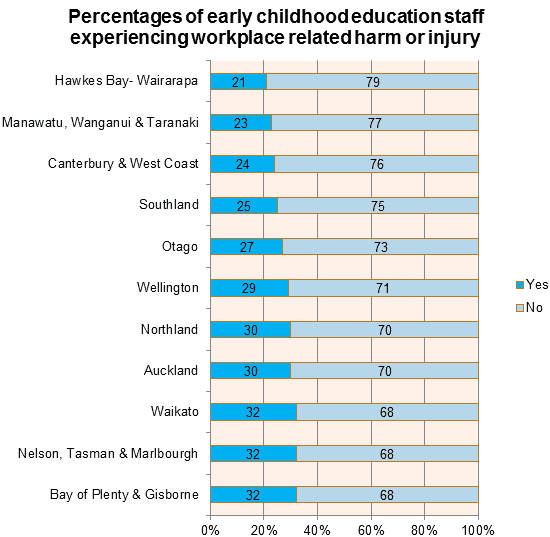
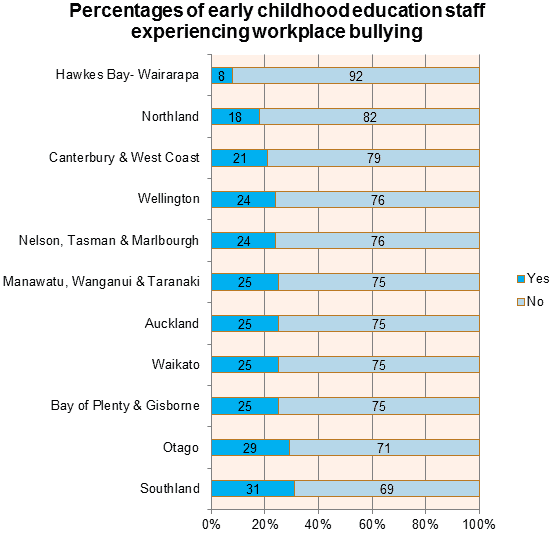
APPENDIX 2 – Examples of Comments Made by Staff
Some examples of workplace injuries:
• I tripped over toy clutter – back injury
• Slipped on wet floor – needed physical therapy
• Chemical in my eye from a toy
• A whiteboard fell on my knee
• Currently off with a torn acl (anterior cruciate ligament) and meniscus. I walked around a table to take a resource off a child and hit a chair while twisting my knee.
• Concussion from banging into a low cupboard
• Bitten by a dog when on a home visit
• I cut my toe badly, nearly severed it due to poor storage in the outside storage shed
• Hearing damage from environment (chairs slammed on floor, group noise) and children yelling right by my ear
• We had issues with a child injuring staff. I have permanent scars from two bites to my wrist.
Examples of staff stress:
• There are many stressful moments throughout the day due to poor ratios / staff numbers and unsettled or settling children, etc.
• Was so stressed last week after a staff meeting at which shouting occurred and staff refused to support me that I wanted to cry.
• Staff at our centre use me to sound off to which creates stress for me as no-one is happy with our day.
• It’s the constant politics of the staff. Am I being watched with a negative eye? Is management making yet another inaccurate assumption about my teaching practice? Why don’t they talk to me respectfully so that they can discover I have sound educational reasons?
• A lot of the stress comes from deficit language used by the manager and the impact this has on the team in general.
• High demand for my time due to there being unqualified and young non English speaking staff.
• The stress of working harder because other teachers (unqualified) either don’t have the skills or don’t care. I wish management would follow this up and monitor the situation.
• Too many older teachers. I found myself having to support the older teachers more than developing my own practice.
• We are pressured to keep up with cleaning throughout the day – changing nappies – doing washing in the laundry – portfolios and transitioning children to other rooms etc. It means the time teachers actually spend in the room is very inconsistent. Often two teachers with 16 under twos… It’s ridiculous.
• Ratios are not suitable when you have three babies in desperate need of something and there is only one of you and infants have to wait for bottles or nappy changes when they shouldn’t have to wait.
• I am in a low decile area and there are all sorts of situations occurring. I have an action plan with the local police that I renew yearly.
• Emotional stress and burnout has led me to ask to work only a 4 day week, instead of a 5 day week , as I was so disillusioned, stressed and exhausted, physically and emotionally.
• Since being in charge I have been on anti-depressants to help me deal with the stress
• I have become so run down I experienced several months of physical ill health. I have seen a counsellor to assist with my mental health.
• Mental stress due to concern over child numbers being low, and discussions around restructuring of the roll and reducing staff numbers.
Examples of bullying experienced by staff:
• My boss nasty person really yells and demeans me
• Colleagues ignoring me and making not nice remarks. Making me feel very disrespected.
• I am not a NZ citizen and I come from a different country. Some of my workmates have said mean things to me indirectly or behind my back for instance about the food that we eat in my country or my culture or my features.
• By other teachers, I’m deemed less knowledgeable because I don’t have children of my own.
• By the owner – regarding my weight.
• By my boss. Anything that went wrong she would blame me for example helping a parent with a payment, my boss taught me how to do it but told me off for doing it.
• By the head teacher and one other staff member, when standing up for the safety of children and myself, I get isolation, silence, talking behind my back.
• Manager implying that our team should not have breaks as we are too busy. Managers saying that our room is too messy after a busy day and keeping us at work (several hours after we were due to finish – unpaid). Teachers blaming each other and lying about tasks for fear of harsh reprimands by management.
• Two older teachers at our centre who did not want to change – one was passive aggressive and a saboteur and the other was vocal in her opposition.
• The treasurer yelling at me about compliance and he was wrong.
• All the ladies I work with are bullies, its poison where I work. It’s a nasty place to be.
• Bullying between centre team members: holding keys to storage, demeaning people by making them ask for the keys, then saying ‘no we are not having that out today. Shouting, stand over tactics, storming out when can’t get own way. Forging alliances with one other and sidelining others from conversations. Unprofessional and unfriendly nasty behaviour that we wouldn’t tolerate for a second in children.
Examples of bullying with threats to job security
• Higher management say if we don’t go to unpaid staff meetings or management meetings in our own time it is a ‘non-compliance’. If teachers don’t like things they can leave.
• Everyone is scared of having their teacher registration refused to be signed off by the manager as that is happening at the moment. The manager writes group emails that obviously makes little digs at certain people.
• Management – I’m bullied into being at staff meeting when I’m sick and have children’s school appointments. I get phoned at home.
• Head teacher – very critical of my work, shouting, saying nasty things and threatening to have me fired.
Examples of regular stress suffered by staff
• Sometimes there are not enough hours in the day to work on requirements set out by the Education Review Office for example self-review when our main priority is engaging in meaningful relationships with the children and their families.
• As a team leader there are high expectations around my workload, in addition I am intrinsically motivated to ‘get things done’ and motivate the team and let them know how valued they are. This in itself adds work and pressure as I always end up as the ‘go to girl’ for everything and anything that needs doing.
• I haven’t had a lunch break since I started, regularly cover both ends of the day, take work home, have to go back to monitor alarm list goes on and on.
• We do not have enough non-contact time to complete learning stories and do all the other things necessary. We are paid for 2 hours’ planning each month but last month had at least 10 other hours of meetings we weren’t paid for and having to prepare and agree a new programme for oldest children, attend meetings with a psychologist about a disturbed child, and organise and run a fundraiser.
• I am employed 24 hours per week and I am expected to do the work the 40 hours per week staff do and am paid less.
• It is my second year of teaching and I am currently in the process of teacher registration. I spend at least 8-10 hours of my own time, completing the required paperwork.
ENDS …





